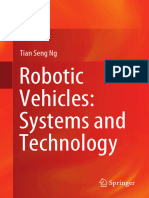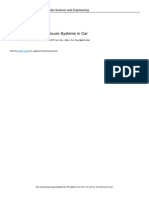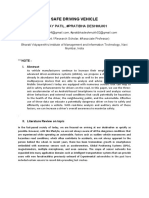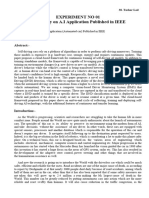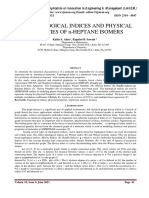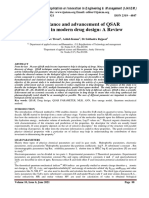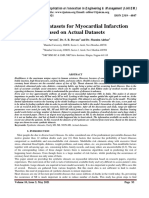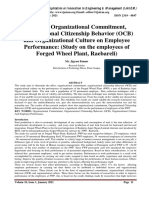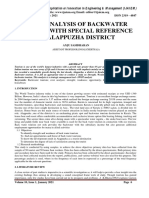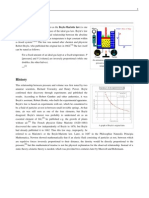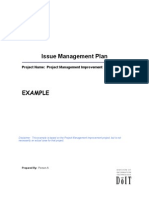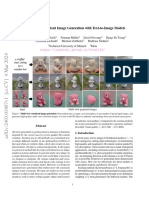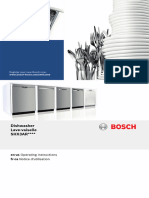0 ratings0% found this document useful (0 votes)
30 viewsOn The Realization of Autonomous Cars in Diverse Conditions
On The Realization of Autonomous Cars in Diverse Conditions
International Journal of Application or Innovation in Engineering & Management (IJAIEM)
Web Site: www.ijaiem.org Email: editor@ijaiem.org
Volume 3, Issue 9, September 2014 ISSN 2319 – 4847, ISRA Journal Impact Factor:
3.115
Copyright:
© All Rights Reserved
Available Formats
Download as PDF, TXT or read online from Scribd
On The Realization of Autonomous Cars in Diverse Conditions
On The Realization of Autonomous Cars in Diverse Conditions
0 ratings0% found this document useful (0 votes)
30 views6 pagesInternational Journal of Application or Innovation in Engineering & Management (IJAIEM)
Web Site: www.ijaiem.org Email: editor@ijaiem.org
Volume 3, Issue 9, September 2014 ISSN 2319 – 4847, ISRA Journal Impact Factor:
3.115
Original Title
IJAIEM-2014-10-01-95
Copyright
© © All Rights Reserved
Available Formats
PDF, TXT or read online from Scribd
Share this document
Did you find this document useful?
Is this content inappropriate?
International Journal of Application or Innovation in Engineering & Management (IJAIEM)
Web Site: www.ijaiem.org Email: editor@ijaiem.org
Volume 3, Issue 9, September 2014 ISSN 2319 – 4847, ISRA Journal Impact Factor:
3.115
Copyright:
© All Rights Reserved
Available Formats
Download as PDF, TXT or read online from Scribd
Download as pdf or txt
0 ratings0% found this document useful (0 votes)
30 views6 pagesOn The Realization of Autonomous Cars in Diverse Conditions
On The Realization of Autonomous Cars in Diverse Conditions
International Journal of Application or Innovation in Engineering & Management (IJAIEM)
Web Site: www.ijaiem.org Email: editor@ijaiem.org
Volume 3, Issue 9, September 2014 ISSN 2319 – 4847, ISRA Journal Impact Factor:
3.115
Copyright:
© All Rights Reserved
Available Formats
Download as PDF, TXT or read online from Scribd
Download as pdf or txt
You are on page 1of 6
International Journal of Application or Innovation in Engineering& Management (IJAIEM)
Web Site: www.ijaiem.org Email: editor@ijaiem.org
Volume 03, Issue 09, September 2014 ISSN 2319 - 4847
Volume 3, Issue 9, September 2014 Page 262
ABSTRACT
Automation has revolutionized the entire world intending to make human existence simpler at the same time well
ahead of time memorial. In this techno-savvy realm every day in automation comes with a new innovation trying to
be a part of our life. However, this magnificent improvement comes at the cost of rising side effects which
essentially covers accidents (owing mostly to human errors), fuel price hikes, and damage to mankind and natural
resources thus hiking complications. This necessitates better and modified autonomous systems to improve human
existence standards. An attempt to address these issues with objective of enhanced simplicity and safety is proposed
as an autonomous or driverless car design with aided features. The proposed design aims to bring into light the
usage of autonomous cars in comparison to the existing cars and reflects the significant features and related
changes it offers. Through this work, the design and mandatory doctrines of proposed autonomous car are
comprehensively communicated. Basic factors viz., road, weather, overtaking, existing traffic conditions are
thoroughly analyzed and selected special features are added and to design the autonomous car as per the worst
environmental and physical conditions possible. With the presence of self-sustaining cars in automation domain, it
is widely expected to bring drastic increase in present safety levels monetarily, naturally, reduction in causalities,
thefts and crime control along with simplifying world around us and to play a major role in future automation.
Keywords: Automation, autonomous car, vehicle-communication, object-detection, safety
1. INTRODUCTION
Automation is an important part of human existence which has contributed incessantly to simplify our lives. From time
memorial, automation domain has gravitated from carts to supersonic jets to in recently autonomous or driver-less
implying to co-relate with our surroundings. Self-sustaining or autonomous car are widely believed to be capable of
fulfilling human transportation needs similar to the standard existing cars. Being driverless, they are made proficient to
sense the environment and navigate without the human input with the aid of electronics techniques like radar, LIDAR
sensor, GPS, camera. The sole reason of their existence is to overcome the shortcoming of present day automation with
enhanced safety and simplicity levels.
(a) (b)
On the Realization of Autonomous cars in
diverse conditions
Abhishek Patnaik
1
and Pratik Tiwari
2
1
B.Tech Student, Dept. of Instrumentation and Control Engineering, SRM University, Chennai, Tamil Nadu,
India
2
B.tech Student, Dept. of Aerospace Engineering, SRM University, Chennai, Tamil Nadu, India
International Journal of Application or Innovation in Engineering& Management (IJAIEM)
Web Site: www.ijaiem.org Email: editor@ijaiem.org
Volume 03, Issue 09, September 2014 ISSN 2319 - 4847
Volume 3, Issue 9, September 2014 Page 263
(c)
Figure 1. Data representation of fatal accidents and related casualties in major cities in India (a) Northern region (b)
Southern region (c) Central region
The alarming rise in number of fatalities (please see fig.1) from last few decades owing to present automation demands
superior and well controlled systems. The vision to modify the automation industry with an autonomous car is actively
pursued following the classical achievement by Mercedes Benz in 1980. A simple driverless van was devised and
driven for few kilometers with speed could range up to a maximum of 100 km/hr. This lead to leading automobile
industries like Volvo, Renault, Audi, BMW, and General Motors etc. started working on autonomous car. These
industries have contributed with their own techniques in the field of driverless cars. Volvo have defined awareness with
vehicle to vehicle communication, Audi introduced automatic parking & traffic jam pilot, Mercedes introduced
distronic plus in which driver is warned by visual and acoustic signal. All the above mentioned works have reflected in
advanced pace of autonomous cars being realization on the road. All these significant contributions are different aspects
which are certainly mandatory for an autonomous car and over time have resulted in a commercially available
autonomous car as open air shutter with viable maximum speed of 12.1 miles per hour in USA. Having established that
the autonomous cars are much better options than the existing ones and have a broader role to play in future however,
upon careful introspection, one can notice that there are aspects and conditions which are yet to be addressed in view of
an autonomous car. Hereby, in the proposed design an attempt is made to cover the untouched aspects of the existing
autonomous car technology to make it commercially verifiable option in future automation. The entire proposed design
of the work is developed by considering worst possible situations for the autonomous cars to perform and sustain. A
busy Indian road and associated circumstances were thoroughly considered for the proposed design with a futuristic
view of having an autonomous car in a developing country like India.
2. PROPOSED DESIGN
The vision of a driverless car is accomplished with incorporating essential changes for basic needs viz., road, weather,
overtaking, parking, speed control and prevailing traffic conditions. Furthermore, in comparison to existing cars,
special attention has been laid on additional mandatory features viz., lane Analyses, traffic lights detection, object
detection (living and non-living), fuel analysis, vehicle to vehicle communication, and absence of driver (to avoid
human errors). Almost all of above mentioned features are not present in modern day cars. The efforts are put together
to have a basic car which can realize necessities and is affordable (cost effective) to a wider section. The aspect wise
exploration of entire design is discussed below.
a) Lane Analysis
Lane analysis in automation is one of the most common and important aspect to be taken care of especially for self-
sustaining cars. For a car without driver it is made possible using devices like laser and camera. U Up p t ti il ll l n no ow w
a au ut to on no om mo ou us s c ca ar rs s a ar re e t te es st te ed d f fo or r t th he e r ro oa ad ds s w wh hi ic ch h a ar re e w we el ll l p pl la an nn ne ed d a an nd d s st tr ru uc ct tu ur re ed d h ho ow we ev ve er r, , f fo or r p pl la ac ce es s w wh he er re e t th he e
u un ns st tr ru uc ct tu ur re ed d r ro oa ad ds s h ha av ve e g go oo od d p pr ro op po or rt ti io on n i it t i is s y ye et t t to o b be e a ar rt ti ic cu ul la at te ed d. . I In n t th he e p pr ro op po os se ed d d de es si ig gn n, , a au ut to on no om mo ou us s c ca ar rs s a ar re e
s sp pe ec ci if fi ic ca al ll ly y c co on nv ve er rs se ed d w wi it th h u un ns st tr ru uc ct tu ur re ed d r ro oa ad ds s. . F Fi ig gu ur re e 2 2 s sh ho ow ws s t th he e s sc ch he em ma at ti ic c o of f l la an ne e a an na al ly ys si is s f fo or r p pr ro op po os se ed d m mo od de el l. . T Th he e
b ba as si ic c e ex xt te en ns si io on n t te ec ch hn ni iq qu ue e a ad da ap pt te ed d f fo or r t th he e i im ma ag ge e a an na al ly yz zi in ng g a an nd d c co ol ll le ec ct ti in ng g i in nf fo or rm ma at ti io on n f fo or r t th he e l la an ne e f fo or rm ma at ti io on n i is s H Ho ou ug gh h
t tr ra an ns sf fo or rm ma at ti io on n. . T Th he e t te ec ch hn ni iq qu ue e w wo or rk ks s b by y c ca ap pt tu ur ri in ng g i im mp pe er rf fe ec ct t i in ns st ta an nc ce es s o of f o ob bj je ec ct ts s b by y a a v vo ot ti in ng g p pr ro oc ce ed du ur re e. . T Th hi is s v vo ot ti in ng g
p pr ro oc ce ed du ur re e i is s c ca ar rr ri ie ed d o ou ut t i in n a a d de ef fi in ne ed d s sp pa ac ce e, , f fr ro om m w wh hi ic ch h i in nf fo or rm ma at ti io on n a ab bo ou ut t s sp pe ec ci if fi ie ed d o ob bj je ec ct t a ar re e o ob bt ta ai in ne ed d a as s l lo oc ca al l m ma ax xi im ma a
i in n a a s so o- -c ca al ll le ed d a ac cc cu um mu ul la at to or r s sp pa ac ce e t th ha at t i is s e ex xp pl li ic ci it tl ly y c co on ns st tr ru uc ct te ed d b by y t th he e a al lg go or ri it th hm m f fo or r c co om mp pu ut ti in ng g t th he e H Ho ou ug gh h t tr ra an ns sf fo or rm m. .
L La an ne e d de et te ec ct ti io on n i is s d do on ne e t th hr ro ou ug gh h t th he e d de et ta ai il ls s a av va ai il la ab bl le e o on n t th he e r ro oa ad d. . I In n c ca as se es s o of f l la an ne e d di is sa ap pp pe ea ar ra an nc ce e f fr ro om m t th he e r ro oa ad d t th he es se e l le ef ft t
o ov ve er r s si ig gn n a ar re e t th he e k ke ey y t to o c co om mp pu ut te e t th he e i im ma ag ge e a af ft te er r a an na al ly yz zi in ng g a an nd d c co on nv ve er rt ti in ng g i it t i in nt to o a a c co om mp pl le et te e p pa at th h t to o b be e f fo ol ll lo ow we ed d. . T Th he e
p pr ro op po os se ed d d de es si ig gn n c ca an n p pr ro oc ce es ss s t th he e u un ns st tr ru uc ct tu ur re ed d r ro oa ad d a al ls so o a al lo on ng g w wi it th h o ot th he er r n na at tu ur ra al l p pr ro ob bl le em ms s l li ik ke e r ra ai in n a an nd d f fo og g. .
International Journal of Application or Innovation in Engineering& Management (IJAIEM)
Web Site: www.ijaiem.org Email: editor@ijaiem.org
Volume 03, Issue 09, September 2014 ISSN 2319 - 4847
Volume 3, Issue 9, September 2014 Page 264
Figure 2. Schematic of Lane Analysis
F Fu ur rt th he er r i it t i is s d de ef fi in ne ed d i in n t th he e p pr ro op po os se ed d d de es si ig gn n t th ha at t t th he e l la an ne e a an na al ly ys si is s w wi il ll l a ad dv va an nc ce e t th he e t te ec ch hn ni iq qu ue e o of f o ov ve er rt ta ak ki in ng g a as s t th he e s so ou ur rc ce e
c ca ar r h ha av ve e t to o s sw wi it tc ch h a as s w we el ll l a as s c co om me e b ba ac ck k t to o i it ts s o or ri ig gi in na al l l la an ne e. . I It t i is s a al ls so o i im mp po or rt ta an nt t t to o n no ot ti if fy y t th he e v ve eh hi ic cl le es s b be eh hi in nd d w wh hi il le e
c ch ha an ng gi in ng g t th he e l la an ne e f fo or r o ov ve er rt ta ak ki in ng g m ma an ne eu uv ve er ri in ng g. . T Th hi is s m ma ak ke es s t th he e d de es si ig gn n m mo or re e e ef ff fe ec ct ti iv ve e t th ha an n t th he e e ex xi is st ti in ng g o on ne es s. .
b) Overtaking
A driverless car is mostly expected to overtake while in use. Safe overtaking is expected to have vehicle crossing another
vehicle safely well aware of vehicle coming from behind from opposite direction. At the same time, the overtaking
aspect of driving is also associated with being major cause of the road accidents. For instance, the health and safety
authority have confirmed India as the country leading the list of the fatalities caused by the road accidents (please refer
fig.1). In the proposed design, systematically maneuvering and overtaking is accomplished by a developed algorithm
with due consideration to the reliability of the car. Figure 3 highlights the overtaking scenario by the proposed model. In
this algorithm, the source car first detects the vehicle ahead and calculates the distance using ultrasonic sensors and
measures the relative speed. A stereo camera is utilized to detect the vehicle by using edge detection technique. In case
of vehicle approaching from other end viz., in two lane road systems, the source vehicle detects and moves within safe
distance checks the speed of the incoming vehicle and then enters the second stage of decision for overtaking. The
decision to overtake primarily depends upon the calculated speed and is taken spontaneously within selected distance
from the front vehicle. The time difference between source vehicle and vehicles coming from behind as well as from
opposite direction is measured. If the detected speed lies in the speed interval defined in algorithm then the time
difference is compared by the source vehicle and the upcoming vehicle. Before the source car overtakes, it has to
acknowledge about the vehicles distance from the vehicle ahead of source vehicle so that the source car safely overtakes
and return safely to the same lane at a safety distance from the car behind. It is important to note that, this method could
be very effective in detection and prevention of road accidents.
International Journal of Application or Innovation in Engineering& Management (IJAIEM)
Web Site: www.ijaiem.org Email: editor@ijaiem.org
Volume 03, Issue 09, September 2014 ISSN 2319 - 4847
Volume 3, Issue 9, September 2014 Page 265
Figure 3. Schematic of overtaking by an autonomous vehicle
c) Vehicle to vehicle communication
To avoid road accidents and related losses, the most important criteria is definite communication between two vehicles.
Communication between two vehicles is largely affected by overtaking, switching of lanes, road traffic, human crossing
etc. The existing automation systems are made to adopt to significant methods which still remains questionable. This
alarming and essential part of driving in proposed autonomous cars is adjusted with Dopplers effect. According to the
Dopplers effect the ultrasonic wave are ejected to detect any objection in the path. The wave path is found to be
disturbed by any object in between the source while moving in towards or in opposite direction. Hereby, vehicles
communicate using ultrasonic waves which are send from the car and have a receiver of a defined pitch. The pitch is
usually defined from vehicle to vehicle and receives the waves at a particular frequency.
Figure 4. Schematic of vehicle to vehicle communication
Once the signal is received from the vehicle the appropriate decision is taken. With this, the important factors like
speed of vehicles in a closed range and corresponding motion will be noted. The entire conceptualization is explained
in figure 4 for careful understanding. The addition attribute of vehicle to vehicle communication is that it assist other
International Journal of Application or Innovation in Engineering& Management (IJAIEM)
Web Site: www.ijaiem.org Email: editor@ijaiem.org
Volume 03, Issue 09, September 2014 ISSN 2319 - 4847
Volume 3, Issue 9, September 2014 Page 266
vehicles coming behind for the object detection such as stray animals, pits, projections and pedestrians. Furthermore it
also inform about the signs that are present on the roads alike traffic signals. Theoretically, this is the most effective
and reliable method and if implemented would be of great help in preventing accidents owing to prior information
because of proper communication.
d d) ) O Ob bj je ec ct t D De et te ec ct ti io on n
T Th he e c co on nc ce ep pt t b be eh hi in nd d t th hi is s t te ec ch hn ni iq qu ue e i is s t to o m ma ap p t th he e e en nv vi ir ro on nm me en nt t a an nd d i id de en nt ti if fy y t th he e s st ti il ll l a an nd d m mo ov vi in ng g o ob bj je ec ct ts s a ar ro ou un nd d a an nd d t ta ak ke e
s sa af fe et ty y d de ec ci is si io on ns s f fo or r m mo ov ve em me en nt t o of f t th he e c ca ar r. . T Th he e m mo os st t c ch ha al ll le en ng gi in ng g p pa ar rt t o of f o ob bj je ec ct t d de et te ec ct ti io on n e em me er rg ge es s w wh he en n e en nt te er ri in ng g i in n t th he e
m mo os st t c cr ro ow wd de ed d u ur rb ba an n p pl la ac ce es s w wh he er re e a al ll l k ki in nd d o of f d de et te ec ct ti io on n p pr ro ob bl le em ms s s su uc ch h a as s d de et te ec ct ti io on n o of f p pe ed de es st tr ri ia an ns s, , d de et te ec ct ti io on n o of f v ve eh hi ic cl le es s
a an nd d s st tr ra ay y a an ni im ma al ls s d du ur ri in ng g n ni ig gh ht t h ha as s b be ec co om me e m mo or re e d di if ff fi ic cu ul lt t t to o p pe er rf fo or rm m. . A Al ls so o d du ur ri in ng g h he ea av vy y r ra ai in n a an nd d f fo og g t th he e v vi is si ib bi il li it ty y o of f
t th he e r ro oa ad d b be ec co om me es s l lo ow w a an nd d g ge et ts s d di if ff fi ic cu ul lt t t to o j ju ud dg ge e t th he e s su ur rr ro ou un nd di in ng g a ar ro ou un nd d t th he e v ve eh hi ic cl le e. . I In n t th he e p pr ro op po os se ed d d de es si ig gn n, , t th he e o ob bj je ec ct t
d de et te ec ct ti io on n i is s a ac cc co om mp pl li is sh he ed d b by y a an n a al lg go or ri it th hm m b by y u us si in ng g a a h hi ig gh h e en nd d c ca am me er ra a. . T Th he e c ca am me er ra a d de et te ec ct ts s t th he e o ob bj je ec ct ts s u us si in ng g e ed dg ge e
d de et te ec ct ti io on n t te ec ch hn ni iq qu ue e b by y f fo or rm mi in ng g b bl lo oc ck ks s a ar ro ou un nd d i it t. .
F Fi ig gu ur re e 5 5. . S Sc ch he em ma at ti ic c o of f o ob bj je ec ct t d de et te ec ct ti io on n i in n a au ut to on no om mo ou us s v ve eh hi ic cl le es s
F Fi ig gu ur re e 5 5 d de et ta ai il ls s t th he e o ob bj je ec ct t d de et te ec ct ti io on n t te ec ch hn ni iq qu ue e u us se ed d i in n p pr ro op po os se ed d m mo od de el l. . D Du ur ri in ng g r ra ai in ny y c co on nd di it ti io on ns s a an nd d f fo og g i it t i is s d di if ff fi ic cu ul lt t t to o
a ac cq qu ui ir re e c cl le ea ar r i im ma ag ge e o of f o ob bj je ec ct ts s a an nd d f fo or rm m e ed dg ge e t th he er re ef fo or re e t th he er rm ma al l i im ma ag gi in ng g c ca am me er ra a a ar re e u us se ed d i in n f fo or r s su uc ch h c co on nd di it ti io on ns s. . F Fo or r
s si it tu ua at ti io on ns s l li ik ke e u un ns st tr ru uc ct tu ur re ed d r ro oa ad ds s, , h he ea av vy y t tr ra af ff fi ic c, , p pi it t f fo or rm ma at ti io on ns s a a r ro ob bu us st t a al lg go or ri it th hm m i is s r re eq qu ui ir re ed d f fo or r t th he er rm ma al l i im ma ag gi in ng g
c ca am me er ra a t to o i id de en nt ti if fy y v ve eh hi ic cl le es s a an nd d o ob bj je ec ct ts s d du ur ri in ng g d da ay y t ti im me e. . V Va ar ri io ou us s m me et th ho od ds s h ha av ve e b be ee en n i im mp pl le em me en nt te ed d t to o d de et te ec ct t u un ns st tr ru uc ct tu ur re ed d
r ro oa ad ds s a an nd d p po ot th ho ol le es s s su uc ch h a as s b ba ac ck kg gr ro ou un nd d s su ub bt tr ra ac ct ti io on n, , t te ex xt tu ur re e b ba as se ed d d de et te ec ct ti io on n, , e ed dg ge e d de et te ec ct ti io on n a an nd d p pa at tt te er rn n r re ec co og gn ni it ti io on n
w wh hi ic ch h w wi il ll l b be e u us se ed d a as s p pe er r t th he e c co on nd di it ti io on ns s . .S So o t th he e p pr re es se en nt t d de es si ig gn n f fo oc cu us se es s o on n a a c co om mm mo on n m me et th ho od d f fo or r r ro ob bu us st t d de et te ec ct ti io on n a an nd d i is s
c co om mp pe et te en nt t t to o c co ov ve er r a al ll l t th he es se e a as sp pe ec ct ts s a an nd d w wi il ll l b be e i im mm me en ns se el ly y u us se ef fu ul l t to o d de et te ec ct t t th he e o ob bs st ta ac cl le es s o on n t th he e r ro oa ad d. . A Al ls so o t th he e
i in nf fo or rm ma at ti io on n a ab bo ou ut t t th he e d de et te ec ct te ed d o ob bj je ec ct ts s a ar re e c co om mm mu un ni ic ca at te ed d t to o a al le er rt t t th he e v ve eh hi ic cl le es s b be eh hi in nd d i in n o or rd de er r t to o p pr re ev ve en nt t f fa at ta al l a ac cc ci id de en nt ts s. .
e e) ) S Sm ma ar rt t I In nt te er rf fa ac ce e
W Wi it th h t th he e s sm ma ar rt t i in nt te er rf fa ac ce e, , t th he e p pr ro op po os se ed d d de es si ig gn n i in nt te en nd ds s t to o m ma ak ke e a au ut to on no om mo ou us s c ca ar rs s m mo or re e s se ec cu ur re e a an nd d u us se er r f fr ri ie en nd dl ly y. . S Si im mi il la ar r
t to o s sm ma ar rt t p ph ho on ne es s, , t th he e a au ut to on no om mo ou us s c ca ar r s s m mo od de e o of f f fu un nc ct ti io on n w wi il ll l t to ot ta al ll ly y d de ep pe en nd d o on n t th he e p pr ro og gr ra am m t th ha at t i is s d de ef fi in ne ed d f fo or r t th he e c ca ar r
a as s p pe er r t th he e u us se er r. . T Th hi is s w wi il ll l p pr ro ov vi id de e h hi ig gh he er r s se ec cu ur ri it ty y f fr ro om m t th he ef ft ts s w wh hi ic ch h i in n i it ts se el lf f i is s a a m ma aj jo or r i is ss su ue e t ti il ll l d da at te e. . T Th he e c ca ar r w wi il ll l h ha av ve e
t th he e d da at ta a s sa av ve ed d e el le ec ct tr ro on ni ic ca al ll ly y o on nl ly y f fo or r t th he e a ac cc cu us st to om me ed d u us se er rs s i in n t th he e a ai id d o of f a a p pa as ss sw wo or rd d k kn no ow wn n o on nl ly y t to o t th he e u us se er r. . T Th he e c ca ar r
c co ou ul ld d b be e o op pe en ne ed d o on nl ly y b by y t th hi is s p pa as ss sw wo or rd d a an nd d i in n c ca as se e o of f t th hr re ee e w wr ro on ng g e en nt tr ri ie es s a a m me es ss sa ag ge e w wo ou ul ld d f fl lo oa at t d di ir re ec ct tl ly y t to o t th he e m ma ai in n
u us se er r. . T Th hi is s w wi il ll l b br ri in ng g r re ev vo ol lu ut ti io on ni iz ze e t th he e s sa af fe et ty y o of f t th he e c ca ar rs s. . F Fu ur rt th he er rm mo or re e, , t ta ak ki in ng g o on ne e s st te ep p f fu ur rt th he er r a as s a an n a ad dd di it ti io on na al l f fe ea at tu ur re e
t th he e c ca ar r w wi il ll l h ha av ve e a a h ha ar rd d d di is sk k. . T Th he e h ha ar rd d d di is sk k c ca an n h ha av ve e i im mp po or rt ta an nt t f fi il le es s a an nd d f fo ol ld de er r o of f t th he e u us se er r w wh hi ic ch h o on nl ly y h he e/ /s sh he e c ca an n
a ac cc ce es ss s. . T Th he e d dr ri iv ve e w wi il ll l b be e p pr ro ot te ec ct te ed d b by y b bi io om me et tr ri ic c a au ut th he en nt ti ic ca at ti io on n a an nd d a a p pa as ss sw wo or rd d. . T Th hi is s s sy ys st te em m w wi il ll l b be e u us se ed d b by y t th he e
D De em mo og gr ra ap ph hi ic c d da at ta a a an nd d w wi il ll l b be e a ac cc ce es ss s b by y o on nl ly y t th he e r re eg gi is st te er re ed d f fa am mi il ly y m me em mb be er r. . T Th he e s se ec cu ur ri it ty y i is s s sp pe ec ci ia al ll ly y c co on ns si id de er re ed d a an nd d t th he e
d dr ri iv ve es s, , f fo ol ld de er r a al ll l a ar re e p pr ro ot te ec ct te ed d a an nd d a ac cc ce es ss s o on nl ly y b by y f fa am mi il ly y m me em mb be er rs s. .
International Journal of Application or Innovation in Engineering& Management (IJAIEM)
Web Site: www.ijaiem.org Email: editor@ijaiem.org
Volume 03, Issue 09, September 2014 ISSN 2319 - 4847
Volume 3, Issue 9, September 2014 Page 267
3.CONCLUSIONS
W Wi it th h t th he e l li iv vi id d v vi ie ew w o of f e en nh ha an nc ce ed d s sa af fe et ty y a an nd d s si im mp pl li ic ci it ty y i in n a au ut to om ma at ti io on n w wo or rl ld d, , a a n no ov ve el l m me et th ho od d i in n t th he e f fo or rm m o of f a a c co on nc ce ep pt tu ua al l
d de es si ig gn n i is s p pr ro op po os se ed d f fo or r a au ut to on no om mo ou us s c ca ar rs s p pr re ec ci is se el ly y a ai im mi in ng g a at t m ma ai in nl li in ne e i is ss su ue es s a al lo on ng g w wi it th h i in nc co or rp po or ra at ti io on n o of f s sp pe ec ci ia al l f fe ea at tu ur re es s. .
A As sp pe ec ct ts s y ye et t t to o b be e a ad dd dr re es ss se ed d i in n e ex xi is st ti in ng g a au ut to on no om mo ou us s v ve eh hi ic cl le es s a ar re e t to ou uc ch he ed d a an nd d e ex xp pl lo or re ed d i in n t th he e e el le em me en nt ta ar ry y f fo or rm m. . S Sp pe ec ci ia al l
c ca ar re e h ha as s b be ee en n t ta ak ke en n t to o m ma ak ke e t th he e v ve eh hi ic cl le e m mo or re e s si im mp pl le e a an nd d c co os st t e ef ff fe ec ct ti iv ve e k ke ee ep pi in ng g i in n m mi in nd d r re eq qu ui ir re em me en nt t o of f a au ut to om ma at ti io on n
w wo or rl ld d p po os st t 1 10 0 y ye ea ar rs s. . T Th he e p pr ro op po os se ed d d de es si ig gn n o of f d dr ri iv ve er rl le es ss s c ca ar r i is s e ex xp pe ec ct te ed d t to o b be e e ef ff fe ec ct ti iv ve e e ev ve en n w wi it th h e es ss se en nt ti ia al l t ta as sk k l li ik ke e
o ov ve er rt ta ak ki in ng g, , l la an ne e a an na al ly ys si is s, , o ob bj je ec ct ti io on n d de et te ec ct ti io on n a an nd d v ve eh hi ic cl le e t to o v ve eh hi ic cl le e c co om mm mu un ni ic ca at ti io on n i in n t th he e w wo or rs st t p po os ss si ib bl le e s sc ce en na ar ri io o. . I It t i is s
e ex xt te en ns si iv ve el ly y a an nt ti ic ci ip pa at te ed d t to o b br ri in ng g s se ev ve er re e i in nc cr re ea as se e i in n p pr re es se en nt t s sa af fe et ty y l le ev ve el ls s m mo on ne et ta ar ri il ly y, , n na at tu ur ra al ll ly y, , r re ed du uc ct ti io on n i in n c ca au us sa al li it ti ie es s, ,
t th he ef ft ts s a an nd d c cr ri im me e c co on nt tr ro ol l a al lo on ng g w wi it th h s si im mp pl li if fy yi in ng g w wo or rl ld d a ar ro ou un nd d u us s a an nd d t to o p pl la ay y a a m ma aj jo or r r ro ol le e i in n f fu ut tu ur re e a au ut to om ma at ti io on n. .
References
[1] Schmidhuber, J., "Prof. Schmidhuber's highlights of robot car history IDSIA.CH. N.p., n.d. Web, 2011.
[2] CNET-CES Audi A7 takes the Wheel at CES 2014.(As of 31/08/ 2014)
[3] Auto evolution A Short History of Mercedes-Benz Autonomous Driving Technology.2013. (As of 31/08/2014)
[4] Mercedes Benz.S500 Intelligent Drive.2013.(As of 31/08/2014)
[5] Emerging technologies, Autonomous Cars- Not if but when IHS Automotive 2014
[6] Anup Doshi, Community Driver Intends: A Layered Architecture for Cooperativ Active Safety Applications
2010 13th International IEEE Annual Conference on Intelligent Transport System.
[7] M.A. Bauer, V2Eye: Enhancement of Visual Perception from V2V Communication 8th Annual IEE Consumer
Communication and Networking Conference.
AUTHORS
Pratik Tiwari is undergraduate student in Department of Aerospace Engineering, SRM University
Chennai. He is interested in broad field of heat transfer and combustion. He has worked on convective
heat transfer along with exploring physics in impinging jets. Presently he is investigating smoldering
combustion and automation.
Abhishek Patnaik is undergraduate student in Department of Instrumentation and Control
Engineering, SRM University Chennai. He is interested in broad field of automation and in Image
processing.
You might also like
- Autonomous Driving (Robotic Car) AssignmentDocument25 pagesAutonomous Driving (Robotic Car) Assignmenthenok yirgaNo ratings yet
- Research ProposalDocument2 pagesResearch Proposalapi-316634802No ratings yet
- Pip-Lc Service Manual-02-1Document16 pagesPip-Lc Service Manual-02-1Bernardo Andrés Gilardoni0% (1)
- Mercury Grand Marquis Owners Manual 1998Document152 pagesMercury Grand Marquis Owners Manual 1998Masood Alam FarooquiNo ratings yet
- Assignment1 WriteupDocument3 pagesAssignment1 WriteupVinoth KumarNo ratings yet
- Advances in TechnologyDocument6 pagesAdvances in TechnologyAnonymous vTDrPQpp8eNo ratings yet
- Tian Seng NG Robotic Vehicles Systems and TechnologyDocument207 pagesTian Seng NG Robotic Vehicles Systems and TechnologyMuhammad Khoerul UmamNo ratings yet
- Autonomous Car Literature ReviewDocument4 pagesAutonomous Car Literature Reviewcdkxbcrif100% (1)
- Driving Research PaperDocument8 pagesDriving Research Paperh03318kj100% (1)
- Research Paper-Adam DonahueDocument12 pagesResearch Paper-Adam Donahueapi-468051482No ratings yet
- Research Paper On Driverless CarDocument6 pagesResearch Paper On Driverless Carkiitoaulg100% (1)
- Research Paper On Autonomous CarsDocument6 pagesResearch Paper On Autonomous Carsnynodok1pup3100% (1)
- ProposalDocument7 pagesProposalAveshek DeoNo ratings yet
- Eetimes 1 PDFDocument13 pagesEetimes 1 PDFJuan Francisco Pulido CarrilloNo ratings yet
- Self Driving CarDocument61 pagesSelf Driving Carimmi1989No ratings yet
- Is Driverless Cars The FutureDocument4 pagesIs Driverless Cars The FutureMuhammad QamarNo ratings yet
- Saint Louis University School of Engineering and Architecture Department of Electrical EngineeringDocument12 pagesSaint Louis University School of Engineering and Architecture Department of Electrical EngineeringMr. WftyNo ratings yet
- Assignment 1: AbstractDocument4 pagesAssignment 1: AbstractSaif ChogleNo ratings yet
- Review Paper On Carpooling Using Android Operating System-A Step Towards Green EnvironmentDocument4 pagesReview Paper On Carpooling Using Android Operating System-A Step Towards Green EnvironmentPayal ChauhanNo ratings yet
- Robotics Project Review-1: Title:-Autonomous Car SimulationDocument8 pagesRobotics Project Review-1: Title:-Autonomous Car SimulationPrayNo ratings yet
- Tanyaradzwa Mare Research Project Chapter1-5 2023Document14 pagesTanyaradzwa Mare Research Project Chapter1-5 2023tapiwamuchenje123No ratings yet
- Opening ReportDocument18 pagesOpening ReportKhamraev AzamatNo ratings yet
- Raspberry-Pi Based Secure Systems in CarDocument9 pagesRaspberry-Pi Based Secure Systems in Car泰雄No ratings yet
- A Design of Road Database For Self-Driving VehiclesDocument7 pagesA Design of Road Database For Self-Driving Vehiclesnehal baig100% (1)
- Ai Autonomous Vehicles Paper Exp 1cDocument17 pagesAi Autonomous Vehicles Paper Exp 1cakshayaharitha8No ratings yet
- And The Passenger Will Never Need To Take Control of The Vehicle in A Predefined AreaDocument3 pagesAnd The Passenger Will Never Need To Take Control of The Vehicle in A Predefined AreaAlexandru LiliNo ratings yet
- Driverless CARDocument16 pagesDriverless CARAbhimanyu Singh BhatiNo ratings yet
- Research Paper On Traffic ManagementDocument4 pagesResearch Paper On Traffic Managementafnhemzabfueaa100% (1)
- Documentary On Artificial IntelligenceDocument3 pagesDocumentary On Artificial Intelligencefrancess lykha abellaNo ratings yet
- Chapter 1Document6 pagesChapter 1MelanieNo ratings yet
- Background: Like A Toyota Prius Used by Google and Is Known As An Environmentally Friendly Hybrid CarDocument4 pagesBackground: Like A Toyota Prius Used by Google and Is Known As An Environmentally Friendly Hybrid CarRaikoRyuFukudaNo ratings yet
- 65 Nov2020 PDFDocument7 pages65 Nov2020 PDFPrabhatNo ratings yet
- Self Driving VehicleDocument5 pagesSelf Driving VehicleRohit ChavanNo ratings yet
- Lo Rui Ann Complete IceDocument17 pagesLo Rui Ann Complete Icerui annNo ratings yet
- Ai Lab ManualDocument13 pagesAi Lab ManualtusharladNo ratings yet
- Autonomous Vehicles: Leanne Dominique E. Lopena Giselle R. RanchezDocument22 pagesAutonomous Vehicles: Leanne Dominique E. Lopena Giselle R. RanchezDominique LopenaNo ratings yet
- Embedded Project List With Abstract NewDocument72 pagesEmbedded Project List With Abstract NewSanjana NNo ratings yet
- Literature Review On Automated Car Parking SystemDocument8 pagesLiterature Review On Automated Car Parking Systemfvf2ffp6No ratings yet
- Case 5Document3 pagesCase 5AbduNo ratings yet
- Influence of External Environmental Factors On RanDocument9 pagesInfluence of External Environmental Factors On RanImre ZsombokNo ratings yet
- Advanced Traffic Management System With Emergency Override Using Raspberry PiDocument7 pagesAdvanced Traffic Management System With Emergency Override Using Raspberry PiSai ManjithNo ratings yet
- Lane Change Strategy For Autonomous VehicleDocument43 pagesLane Change Strategy For Autonomous VehicleSamir BachirNo ratings yet
- SYNOPSISDocument4 pagesSYNOPSISProtech MechanicalNo ratings yet
- Academic Reading Sample Task - Matching InformationDocument5 pagesAcademic Reading Sample Task - Matching InformationKabilan MuthukannanNo ratings yet
- Eip Real OneDocument9 pagesEip Real Oneapi-242168208No ratings yet
- Car Pooling Using Android Operating System-A Step Towards Green EnvironmentDocument5 pagesCar Pooling Using Android Operating System-A Step Towards Green EnvironmentIJCERT PUBLICATIONSNo ratings yet
- CBIT SUDHEE 2024 Hackathon Problem Statements FinalDocument8 pagesCBIT SUDHEE 2024 Hackathon Problem Statements Finalhan445436No ratings yet
- Ijarcce 2022 111118Document5 pagesIjarcce 2022 111118IF Uday PrajapatiNo ratings yet
- A Project Proposal To Implement Artificial IntelligenceDocument4 pagesA Project Proposal To Implement Artificial IntelligenceEdson BayotNo ratings yet
- Use of ICT in Automobile IndustryDocument3 pagesUse of ICT in Automobile IndustryPasan De Silva100% (2)
- Comprehension Drill 1Document7 pagesComprehension Drill 1Carmina Gonzales VillaruelNo ratings yet
- Thesis Traffic ControlDocument7 pagesThesis Traffic Controlreneecountrymanneworleans100% (1)
- CarsDocument7 pagesCarsbakari kiluNo ratings yet
- Self Driving CarsDocument5 pagesSelf Driving CarsJhanavi ReddyNo ratings yet
- Chapter 1 5 Development of Wiper System Sensor For Light VehiclesDocument61 pagesChapter 1 5 Development of Wiper System Sensor For Light VehiclesRuby Jane OrioNo ratings yet
- IOT Based Intelligent Traffic Control System: Dept. of ECE, ACSCE, Bengaluru 2018-2019Document27 pagesIOT Based Intelligent Traffic Control System: Dept. of ECE, ACSCE, Bengaluru 2018-2019Rethumon RethuNo ratings yet
- Literature Review of Automated Parking SystemDocument8 pagesLiterature Review of Automated Parking Systemaflstezqg100% (1)
- Research Paper About Traffic CongestionDocument5 pagesResearch Paper About Traffic Congestionegt39dvg100% (1)
- Software Engineering ProjectDocument27 pagesSoftware Engineering Projectcharity diolaNo ratings yet
- What Is An Environmental ModelDocument4 pagesWhat Is An Environmental ModelRohit MundatNo ratings yet
- Essay 12, CorrectionDocument16 pagesEssay 12, CorrectionThế Hoàng ĐặngNo ratings yet
- Martin Ford's Rise of The Robots: Technology and the Threat of a Jobless Future SummaryFrom EverandMartin Ford's Rise of The Robots: Technology and the Threat of a Jobless Future SummaryRating: 1.5 out of 5 stars1.5/5 (2)
- Guide to Automotive Connectivity and Cybersecurity: Trends, Technologies, Innovations and ApplicationsFrom EverandGuide to Automotive Connectivity and Cybersecurity: Trends, Technologies, Innovations and ApplicationsNo ratings yet
- THE TOPOLOGICAL INDICES AND PHYSICAL PROPERTIES OF n-HEPTANE ISOMERSDocument7 pagesTHE TOPOLOGICAL INDICES AND PHYSICAL PROPERTIES OF n-HEPTANE ISOMERSInternational Journal of Application or Innovation in Engineering & ManagementNo ratings yet
- Detection of Malicious Web Contents Using Machine and Deep Learning ApproachesDocument6 pagesDetection of Malicious Web Contents Using Machine and Deep Learning ApproachesInternational Journal of Application or Innovation in Engineering & ManagementNo ratings yet
- Analysis of Product Reliability Using Failure Mode Effect Critical Analysis (FMECA) - Case StudyDocument6 pagesAnalysis of Product Reliability Using Failure Mode Effect Critical Analysis (FMECA) - Case StudyInternational Journal of Application or Innovation in Engineering & ManagementNo ratings yet
- An Importance and Advancement of QSAR Parameters in Modern Drug Design: A ReviewDocument9 pagesAn Importance and Advancement of QSAR Parameters in Modern Drug Design: A ReviewInternational Journal of Application or Innovation in Engineering & ManagementNo ratings yet
- Study of Customer Experience and Uses of Uber Cab Services in MumbaiDocument12 pagesStudy of Customer Experience and Uses of Uber Cab Services in MumbaiInternational Journal of Application or Innovation in Engineering & ManagementNo ratings yet
- The Mexican Innovation System: A System's Dynamics PerspectiveDocument12 pagesThe Mexican Innovation System: A System's Dynamics PerspectiveInternational Journal of Application or Innovation in Engineering & ManagementNo ratings yet
- Soil Stabilization of Road by Using Spent WashDocument7 pagesSoil Stabilization of Road by Using Spent WashInternational Journal of Application or Innovation in Engineering & ManagementNo ratings yet
- An Importance and Advancement of QSAR Parameters in Modern Drug Design: A ReviewDocument9 pagesAn Importance and Advancement of QSAR Parameters in Modern Drug Design: A ReviewInternational Journal of Application or Innovation in Engineering & ManagementNo ratings yet
- Study of Customer Experience and Uses of Uber Cab Services in MumbaiDocument12 pagesStudy of Customer Experience and Uses of Uber Cab Services in MumbaiInternational Journal of Application or Innovation in Engineering & ManagementNo ratings yet
- Performance of Short Transmission Line Using Mathematical MethodDocument8 pagesPerformance of Short Transmission Line Using Mathematical MethodInternational Journal of Application or Innovation in Engineering & ManagementNo ratings yet
- Design and Detection of Fruits and Vegetable Spoiled Detetction SystemDocument8 pagesDesign and Detection of Fruits and Vegetable Spoiled Detetction SystemInternational Journal of Application or Innovation in Engineering & ManagementNo ratings yet
- Synthetic Datasets For Myocardial Infarction Based On Actual DatasetsDocument9 pagesSynthetic Datasets For Myocardial Infarction Based On Actual DatasetsInternational Journal of Application or Innovation in Engineering & ManagementNo ratings yet
- A Comparative Analysis of Two Biggest Upi Paymentapps: Bhim and Google Pay (Tez)Document10 pagesA Comparative Analysis of Two Biggest Upi Paymentapps: Bhim and Google Pay (Tez)International Journal of Application or Innovation in Engineering & ManagementNo ratings yet
- Staycation As A Marketing Tool For Survival Post Covid-19 in Five Star Hotels in Pune CityDocument10 pagesStaycation As A Marketing Tool For Survival Post Covid-19 in Five Star Hotels in Pune CityInternational Journal of Application or Innovation in Engineering & ManagementNo ratings yet
- Impact of Covid-19 On Employment Opportunities For Fresh Graduates in Hospitality &tourism IndustryDocument8 pagesImpact of Covid-19 On Employment Opportunities For Fresh Graduates in Hospitality &tourism IndustryInternational Journal of Application or Innovation in Engineering & ManagementNo ratings yet
- A Deep Learning Based Assistant For The Visually ImpairedDocument11 pagesA Deep Learning Based Assistant For The Visually ImpairedInternational Journal of Application or Innovation in Engineering & ManagementNo ratings yet
- The Effect of Work Involvement and Work Stress On Employee Performance: A Case Study of Forged Wheel Plant, IndiaDocument5 pagesThe Effect of Work Involvement and Work Stress On Employee Performance: A Case Study of Forged Wheel Plant, IndiaInternational Journal of Application or Innovation in Engineering & ManagementNo ratings yet
- Ijaiem 2021 01 28 6Document9 pagesIjaiem 2021 01 28 6International Journal of Application or Innovation in Engineering & ManagementNo ratings yet
- Anchoring of Inflation Expectations and Monetary Policy Transparency in IndiaDocument9 pagesAnchoring of Inflation Expectations and Monetary Policy Transparency in IndiaInternational Journal of Application or Innovation in Engineering & ManagementNo ratings yet
- Swot Analysis of Backwater Tourism With Special Reference To Alappuzha DistrictDocument5 pagesSwot Analysis of Backwater Tourism With Special Reference To Alappuzha DistrictInternational Journal of Application or Innovation in Engineering & ManagementNo ratings yet
- Design and Manufacturing of 6V 120ah Battery Container Mould For Train Lighting ApplicationDocument13 pagesDesign and Manufacturing of 6V 120ah Battery Container Mould For Train Lighting ApplicationInternational Journal of Application or Innovation in Engineering & ManagementNo ratings yet
- Chengpeng Ma 2018Document14 pagesChengpeng Ma 2018Dr.V.K.Bupesh RajaNo ratings yet
- Extended End Plate Moment Connections PDFDocument47 pagesExtended End Plate Moment Connections PDFManvitha Reddy100% (2)
- MS15054 - 00e MtuDocument177 pagesMS15054 - 00e MtuGioeNo ratings yet
- Boyle's LawDocument4 pagesBoyle's LawEn CsakNo ratings yet
- N4 Electrotechnics August 2019 MemorandumDocument7 pagesN4 Electrotechnics August 2019 MemorandumPetro Susan BarnardNo ratings yet
- Performa InvoiceDocument12 pagesPerforma InvoiceAlfian MulyanaNo ratings yet
- FI-2 - Ecolab ManualDocument3 pagesFI-2 - Ecolab ManualNit TasanaNo ratings yet
- Installation and Configuration OMC-R Clean InstallDocument321 pagesInstallation and Configuration OMC-R Clean InstallBabylon_7000BCNo ratings yet
- Lab Manual WeldingDocument83 pagesLab Manual Weldingknizam1971No ratings yet
- February Register 19Document85 pagesFebruary Register 19reubzzzzzzzzzNo ratings yet
- Topic 3 QDocument17 pagesTopic 3 QTofig HuseynliNo ratings yet
- 3.3.3 Example - Issue Management Plan, V2.2Document7 pages3.3.3 Example - Issue Management Plan, V2.2Juan VeronNo ratings yet
- Manual: Serial No................................. Rev. 00Document61 pagesManual: Serial No................................. Rev. 00Kader SllNo ratings yet
- Eksperimen: Untuk Menentukan Muatan Haba Tentu Pepejal Dan CecairDocument2 pagesEksperimen: Untuk Menentukan Muatan Haba Tentu Pepejal Dan Cecairputri_latifahNo ratings yet
- 8 MechanismsDocument21 pages8 MechanismsuzairNo ratings yet
- ViewDiff - 3D - Consisitent Image Generation With Text To Image ModelsDocument22 pagesViewDiff - 3D - Consisitent Image Generation With Text To Image ModelsJeremy WayinNo ratings yet
- Mysql Vs Mariadb Vs Postgresql Comparison Sheet Name MysqlDocument3 pagesMysql Vs Mariadb Vs Postgresql Comparison Sheet Name MysqlAnonymous 9aBmv7GFWNo ratings yet
- Interior Designer NoidaDocument7 pagesInterior Designer NoidasalesNo ratings yet
- Bosch Manual SHX3AR75UC 9001557043 - ADocument87 pagesBosch Manual SHX3AR75UC 9001557043 - AboucheNo ratings yet
- Hydroformed Metal Bellows - Design HandbookDocument128 pagesHydroformed Metal Bellows - Design Handbookchipulino100% (1)
- Principles of MEMS TransducersDocument19 pagesPrinciples of MEMS TransducersTechdevtodo DevtodoNo ratings yet
- Subject - Machine Design - : Topic - Spur GearDocument10 pagesSubject - Machine Design - : Topic - Spur GearRohit GhulanavarNo ratings yet
- Chapter 1Document34 pagesChapter 1Sagni Oo ChambNo ratings yet
- Samsung PM983 NF1 Product Brief FinalDocument2 pagesSamsung PM983 NF1 Product Brief FinalRazan FSHLNo ratings yet
- Modelling, Analysis and Development of Progressive Die For Seat RailDocument9 pagesModelling, Analysis and Development of Progressive Die For Seat RailVineela ChNo ratings yet
- IDOC Overview New PDFDocument60 pagesIDOC Overview New PDFtabti memeNo ratings yet
- Ethernet Cable Color - Code Standards & Methods of Crimping: Presented By: Maria Diorella PaguioDocument26 pagesEthernet Cable Color - Code Standards & Methods of Crimping: Presented By: Maria Diorella PaguioDiorella PaguioNo ratings yet






